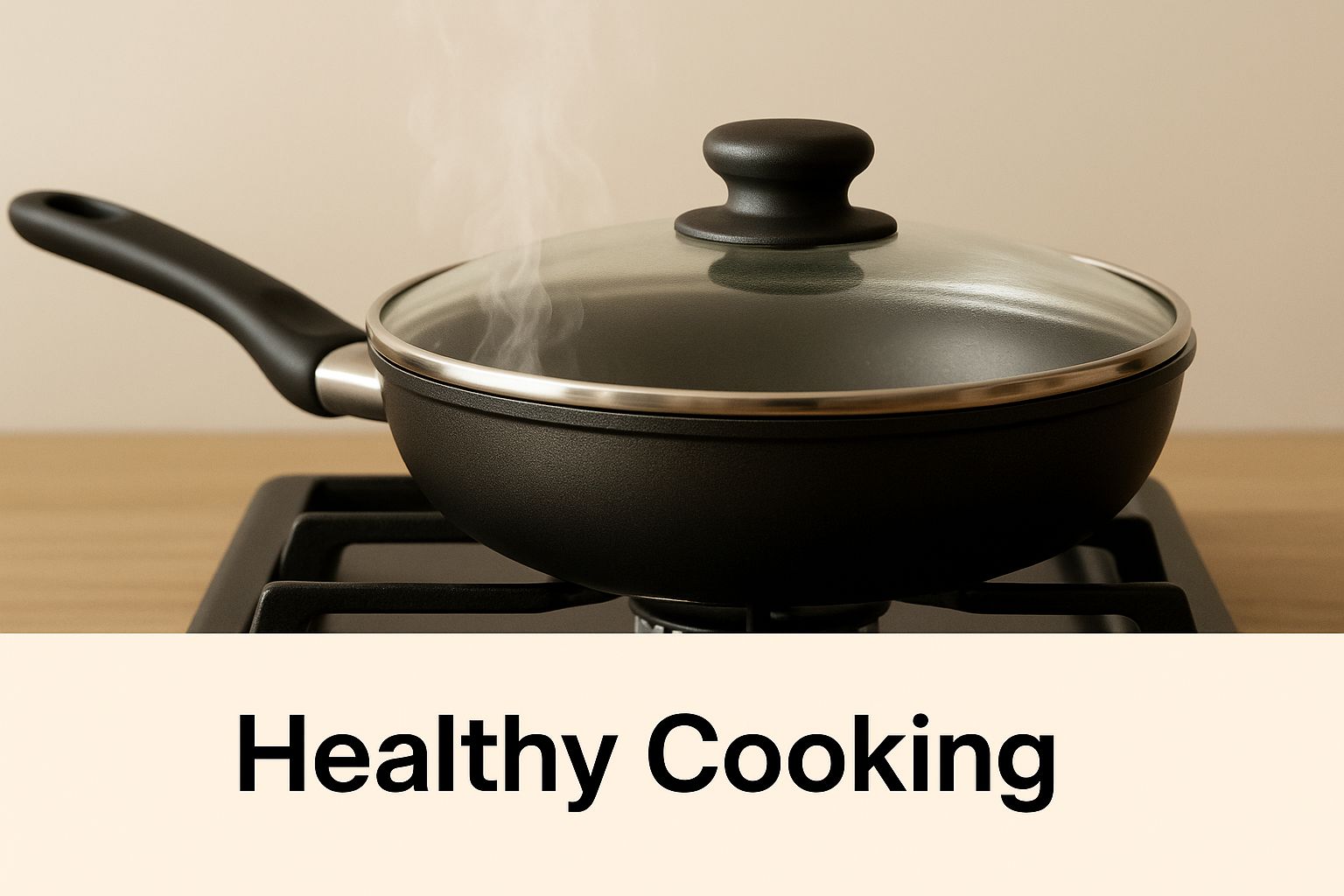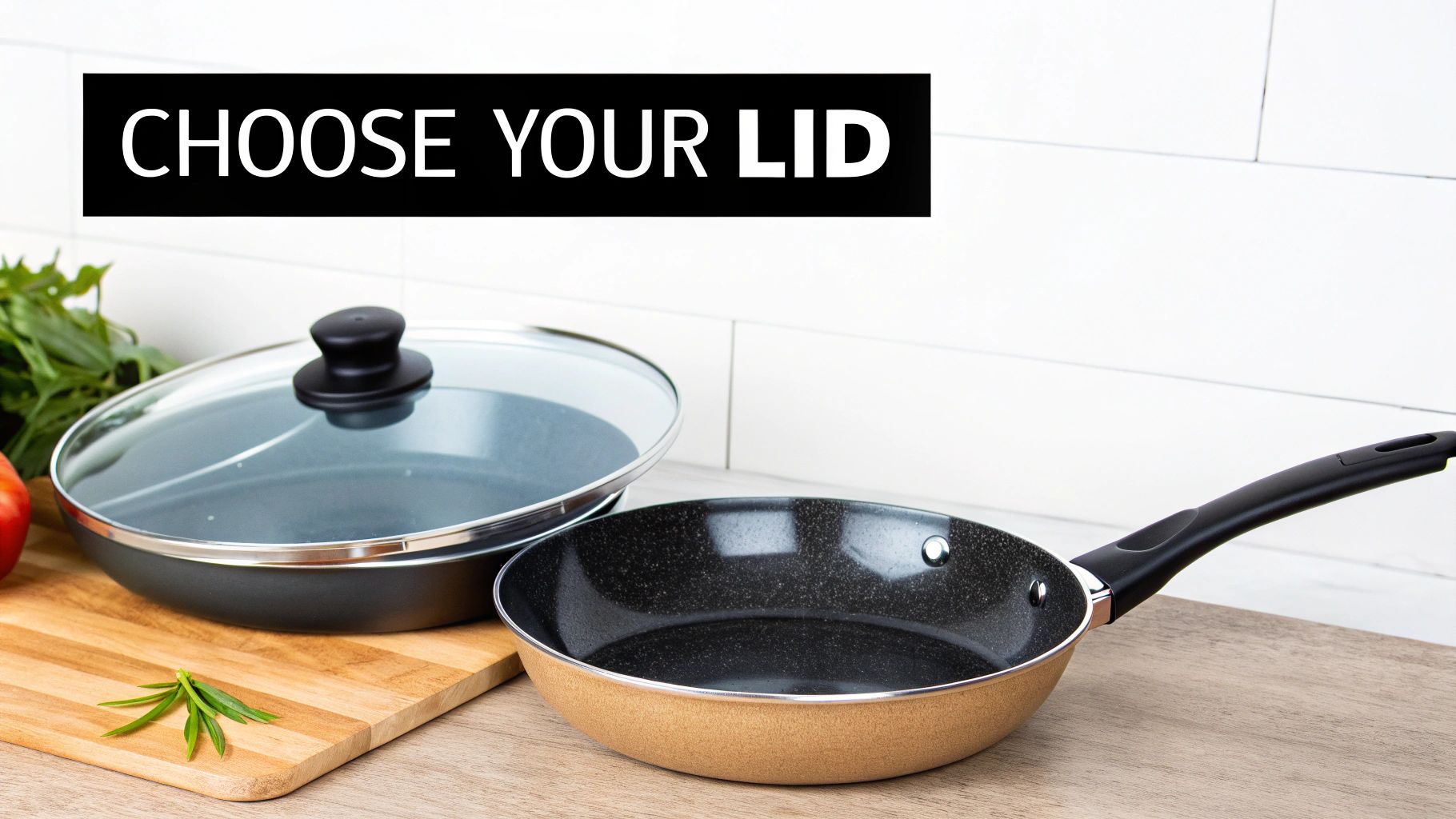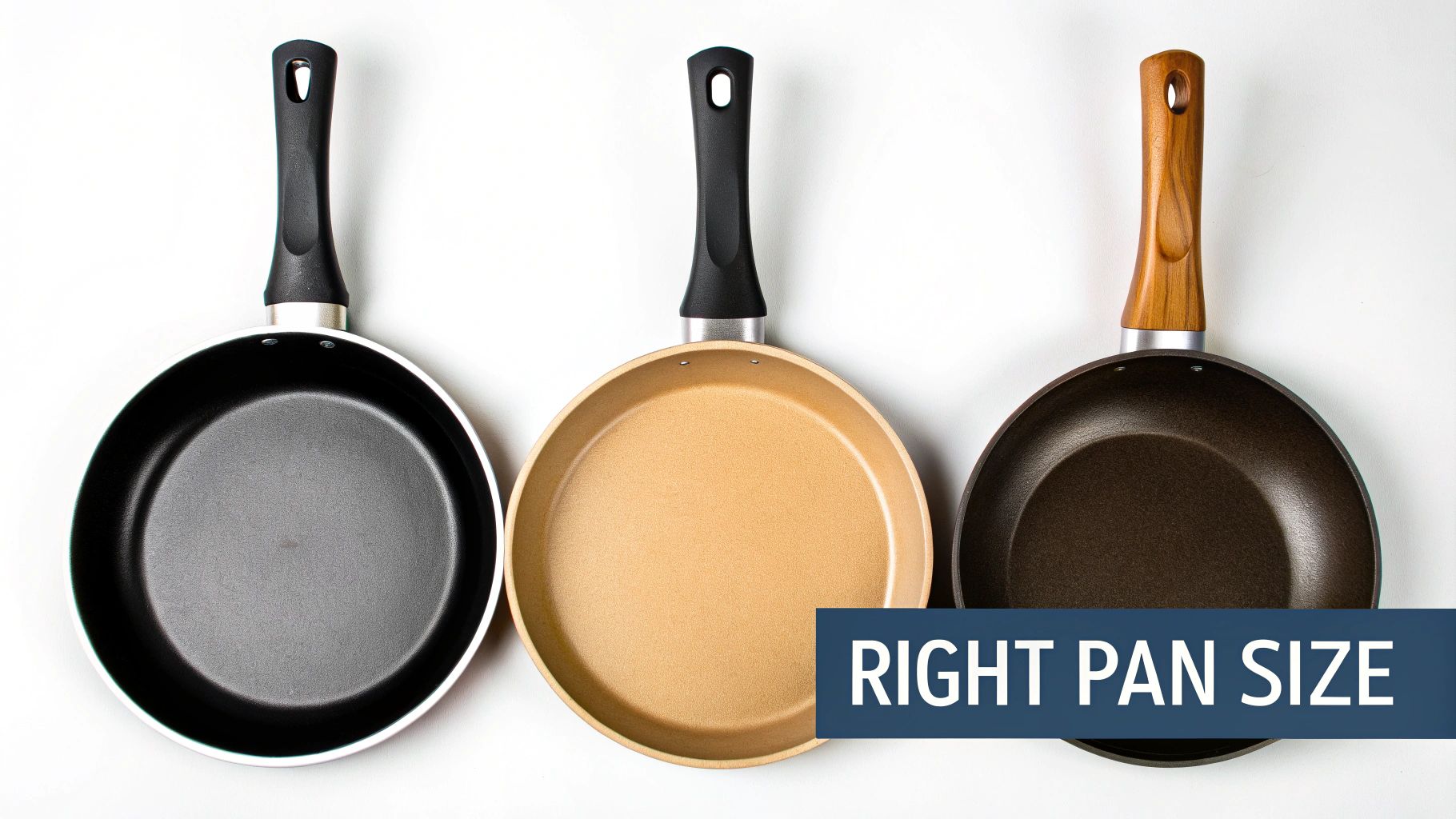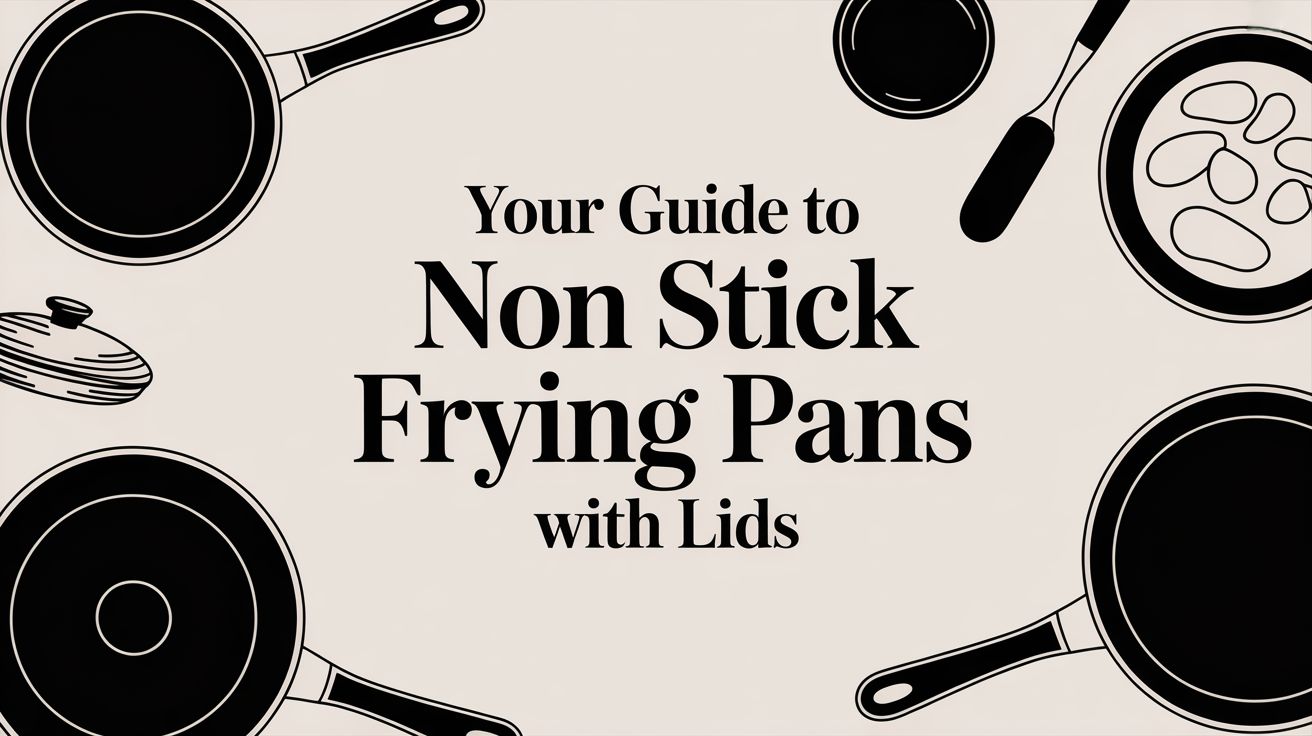A non-stick frying pan with a lid isn't just a piece of cookware; it’s a complete cooking system. This simple combination lets you fry with barely any oil, but it also traps heat and moisture. This unlocks healthier cooking methods like steaming and braising, all in one handy pan.
Why a Non-Stick Pan with a Lid Is a Kitchen Game-Changer
Think of your regular non-stick pan. It’s a bit of a specialist, right? Brilliant for searing a piece of fish or flipping the perfect pancake.
Now, add a lid to that pan. Suddenly, that specialist becomes a versatile all-rounder. The lid traps steam and heat, essentially turning your frying pan into a mini oven right on your stovetop. This one small addition opens up a whole new world of cooking that goes way beyond just frying.
The real magic is how this duo helps you cook healthier meals. The non-stick surface means you can slash the amount of butter and oil you use, cutting down on fats without losing flavour. The lid takes things even further.
- Keeps moisture in: It locks in moisture, gently cooking vegetables so they keep more of their nutrients and stay vibrant and crisp.
- Allows for gentle cooking: You can simmer a sauce without it boiling away too quickly or splattering all over your cooktop.
- Makes steaming easy: It’s perfect for steaming dumplings or a delicate piece of fish, using the trapped moisture to cook food gently.
This move towards healthier, more efficient cooking isn't just a passing fad. The Australian non-stick cookware market, which includes these lidded frying pans, was valued at around USD 254.62 million in 2024. It's expected to grow to USD 356.78 million by 2032, largely because more of us are realising the benefits of cooking with less oil. You can find out more about this market growth and its drivers.
This simple tool really does support healthier habits in the kitchen.

As you can see, the slick surface combined with a well-fitting lid creates the perfect environment for cooking with less fat and locking in more flavour. Ultimately, non-stick frying pans with lids are more than just convenient; they're a smart investment in your health and your creativity in the kitchen.
Understanding Your Pan's Materials and Coatings
Ever wondered what makes a great non-stick pan actually great? It’s not just one thing, but a clever partnership between two key elements: the pan's body and its non-stick coating.
Think of it like a performance car. The body of the pan is the engine, responsible for generating and distributing power (heat). The coating is like a set of high-performance tyres, providing the perfect amount of grip—or in our case, the effortless slip.
The pan's body, or its base material, is the foundation. It determines how quickly and evenly your pan heats up. A poor base material creates frustrating hot spots where food instantly burns, while a great one delivers consistent, reliable heat across the entire cooking surface. Getting this right is the secret to good cooking.
The Engine of Your Pan: Core Materials
Most non-stick frying pans with lids are built from materials chosen specifically for their heat properties and durability. Each one offers a slightly different cooking experience.
-
Aluminium: This is the lightweight champion of the kitchen. It heats up incredibly fast, which is fantastic for quick meals like scrambling eggs or whipping up an omelette. The downside? Basic, thin aluminium can be a bit soft and prone to warping over time.
-
Hard-Anodised Aluminium: This is the tougher sibling of standard aluminium. It’s been put through an electrochemical process that makes it significantly stronger and more durable. You get the same zippy heating but with added toughness that resists scratches and corrosion far better.
-
Stainless Steel: Known for its sheer durability and non-reactive surface, stainless steel is a true kitchen workhorse. It often has an aluminium or copper core sandwiched between layers of steel to massively improve its heat conductivity, giving you the best of both worlds: strength and even heating.
These base materials are the unsung heroes of the cookware world. In fact, materials like aluminium and stainless steel are so essential they make up a 53.41% share of the non-stick cookware market. They ensure pans are robust, conductive, and compatible with all sorts of stovetops, including the induction cooktops so common in modern Aussie homes. You can find out more about these cookware market insights.
The Secret to the Slip: Non-Stick Coatings
While the pan's body manages the heat, the coating is what delivers that satisfying, effortless food release we all love. It’s a very thin layer applied to the interior that stops food from bonding to the metal.
When it comes to non-stick coatings, it's easy to get lost in the jargon. Let's break down the most common types you'll find on the shelf.
Comparing Non Stick Coating Types
| Coating Type | Key Benefit | Heat Tolerance | Best For | Lifespan Consideration |
|---|---|---|---|---|
| PTFE (Teflon) | Exceptional non-stick | Moderate (up to 260°C) | Eggs, pancakes, delicate fish—anything that sticks easily. | Can be scratched by metal utensils. Avoid overheating. |
| Ceramic | PFOA/PTFE-free | High (up to 400°C) | Searing and browning at higher temperatures. | Can lose its non-stick properties faster than PTFE if not cared for. |
| Reinforced (Titanium/Diamond) | Extreme durability | Varies (often high) | Everyday, heavy-duty cooking; for those who want a longer-lasting pan. | Generally more expensive, but the investment pays off in longevity. |
Historically, PTFE (polytetrafluoroethylene) has been the go-to, and for good reason—it’s incredibly slippery. High-quality, modern PTFE coatings are made without PFOA and are perfectly safe for daily cooking when used correctly (which means not overheating them). Ceramic coatings, made from a sand derivative, are another popular choice and can often handle higher temperatures, which is great for searing.
A pan's true performance is all about balance. You need the rapid, even heating of a well-made base combined with a durable, slick coating that can stand up to daily use. One without the other just won’t deliver the results you want.
Some of the best pans on the market go a step further, reinforcing their coatings with super-hard materials like diamond or titanium particles. This isn't just a gimmick; it seriously enhances durability and scratch resistance. These reinforced surfaces promise a much longer lifespan, making them a worthwhile investment for any serious home cook.
If you're curious about cookware made entirely from this premium metal, you can explore our guide on the pros and cons of using titanium cookware. Understanding this synergy between the pan’s body and its coating is what will empower you to choose a pan that truly performs.
How to Choose the Right Lid for Your Pan

A good lid is what transforms a simple frying pan into a kitchen workhorse. It’s the secret ingredient that unlocks a whole new world of cooking techniques, taking you from just frying to simmering, steaming, and braising with ease. But not all lids are created equal, and the best one for you really comes down to how you cook.
Picking the perfect partner for your pan goes beyond just finding one that fits. The material, the handle, and a few clever features can completely change your cooking game. A well-chosen lid traps flavour, controls moisture, and gives you the confidence to try those recipes you've been eyeing.
Lid Materials: Glass vs. Steel
When you’re looking at non stick frying pans with lids, the lid itself usually comes in one of two materials. Each has its own personality in the kitchen.
-
Tempered Glass Lids: The big win here is visibility. Being able to see what’s happening inside the pan without lifting the lid is a game-changer. You can watch your sauce gently bubble or check the colour on your veggies, all while keeping that precious heat and steam locked in. They're brilliant for any dish that needs a watchful eye.
-
Stainless Steel Lids: These lids are the tough guys. They’re often lighter than glass and practically indestructible if you happen to drop one. Their real strength lies in trapping heat and moisture, creating the perfect steamy environment for braising tough cuts of meat or steaming dumplings to perfection.
So, think of it this way: a glass lid is for the hands-on cook who loves to watch their creation come to life. A stainless steel lid is for the cook who trusts the process and wants maximum heat retention.
Key Features to Look For
It’s the little things that often make the biggest difference, and pan lids are no exception. A great lid isn't just a cover; it's an active tool in your cooking.
First and foremost, a snug fit is absolutely essential. A lid that sits tightly on the pan's rim is your best friend for trapping heat and moisture. This ensures your food cooks evenly and stays juicy and flavourful. A wobbly, loose lid is a recipe for disaster, letting steam escape and drying out your meal.
The most overlooked feature is often the simplest: a small hole known as a steam vent. This tiny opening is a lifesaver, allowing excess pressure to escape so your liquids don't boil over and make a mess of your stovetop. If you plan on simmering sauces or soups, this is a must-have.
Finally, give the handle a good look. Is it comfortable to hold? And, critically, is it oven-safe? An oven-safe handle, usually made from stainless steel or a high-quality silicone, makes your pan incredibly versatile. It means you can sear a steak on the cooktop and then slide the whole pan straight into the oven to finish it off. This stovetop-to-oven talent turns your frying pan into a true do-it-all piece of cookware.
Finding the Perfect Pan Size and Shape for Your Needs

Walking into a kitchenware store can feel a bit overwhelming with all the options. But when it comes to frying pans, size really does matter. Picking the right one isn't just about what looks good; it's about matching the pan to your everyday cooking needs so it becomes your go-to tool, not another piece of clutter.
So, where do you start? The diameter is the most important factor. A small 20cm pan is a solo cook’s dream, perfect for whipping up a quick omelette or searing a single fillet of fish. If you’re cooking for two to four people, a 26-28cm pan is the sweet spot. It's the undisputed champion of versatility in most Aussie kitchens, giving you plenty of room to cook without everything getting crowded.
It's no surprise that the frying pan is projected to hold the largest slice of the non-stick cookware market in Australia and New Zealand, with a forecast 18.26% market share in 2025. It's the workhorse we all rely on for everything from bacon and eggs to stir-fries.
To help you visualise which size is right for you, here’s a quick guide.
Frying Pan Size Guide for Australian Households
This table breaks down the common pan sizes and what they're best used for in a typical household.
| Pan Diameter (cm) | Ideal for Household Size | Common Uses |
|---|---|---|
| 20cm | 1 person | Frying 1-2 eggs, toasting nuts, single-serve meals. |
| 24cm | 1-2 people | Small omelettes, reheating leftovers, sautéing for two. |
| 26-28cm | 2-4 people | The all-rounder for family meals, searing meats. |
| 30-32cm | 4+ people | Large family dinners, cooking in batches, paellas. |
Choosing the right size ensures your food cooks evenly and you're not wasting energy heating a giant pan for a small meal.
Shape Defines Function
Beyond just the width, the shape of a pan completely changes how it cooks. You'll generally find two main styles, and each one shines in different situations.
-
Classic Frying Pan (Sloped Sides): This is the pan most of us picture. Those curved, sloping sides are brilliant for active cooking. They make it easy to toss ingredients, slide a pancake onto a plate, and let steam escape for a perfect, crispy sear.
-
Sauté Pan (Straight Sides): With its tall, vertical sides and wider flat base, this pan is your go-to for anything with liquid. It’s ideal for simmering sauces, braising meats, or shallow-frying, as the high walls do an excellent job of preventing splatters.
Think of it this way: a classic frying pan is built for agility and quick cooking, while a sauté pan is designed for control, especially with sauces and liquids. Knowing which one suits your cooking style makes all the difference.
Ultimately, picking the right non-stick frying pans with lids is about being honest about how you cook. That huge 32cm pan might look professional, but if you’re usually just cooking for yourself, it’ll be more of a hassle than a help.
By matching the size to your household and the shape to your favourite recipes, you’ll find a true kitchen partner. A great pan is the foundation of so many delicious meals, so take a look at a quality collection of kitchenware to find the perfect one for you.
Easy Habits That Make Your Pan Last for Years
A great non-stick pan is a serious ally in the kitchen, but it's not indestructible. The good news is, you don’t need a complicated maintenance routine to keep it in top shape. It's all about a few simple habits that protect its delicate surface. Get these right, and you'll be enjoying that effortless food-release for a long, long time.
Think of that non-stick coating as the pan's superpower. It works wonders, but it has its weaknesses. The three biggest villains are extreme heat, sharp utensils, and harsh cleaning. A little bit of mindfulness is all it takes to keep them at bay.
If you treat your pan with a bit of care, it'll pay you back with perfectly cooked, easy-to-clean meals every time. Let’s dive into the simple do's and don'ts that make all the difference.
The Do's: Your Pan's Best Friends
These are the small, positive habits that will keep your non-stick surface pristine.
-
Stick to Soft Utensils: Make silicone, wood, or nylon tools your go-to. These materials are kind to the coating and won't cause the tiny scratches that eventually lead to food sticking. Metal utensils, on the other hand, are the fastest way to ruin a non-stick surface.
-
Keep the Heat at Medium: Non-stick pans are superstars at conducting heat, so you rarely need to crank the dial. High temperatures can cause the coating to break down and can even release fumes. If you need a good sear, just let the pan preheat on a medium setting for a minute or two. You'll get that beautiful crust without punishing the pan.
-
Wash by Hand: I know, I know—some pans say "dishwasher safe." But the reality is that the high heat and abrasive detergents in a dishwasher are tough on non-stick coatings. A quick, gentle wash in the sink with a soft sponge and a bit of dish soap is the absolute best way to keep it going strong.
The Don'ts: Habits to Avoid at All Costs
Just as crucial as the do's are the things you should never, ever do. Steer clear of these common mistakes to protect your pan.
First up, never heat an empty pan on high heat. With no food in it to absorb the energy, the temperature can climb incredibly fast, causing permanent damage to the non-stick layer before you even realise it.
Next, step away from the aerosol cooking sprays. They seem like a great shortcut, but they contain propellants and other additives that can burn onto the surface, leaving behind a sticky, gunky build-up that's nearly impossible to scrub off. This residue completely neutralises the non-stick effect. A tiny bit of oil or butter is all you need.
The single most important tip? Let your pan cool down completely before washing it. Dunking a sizzling-hot pan into cold water can cause thermal shock, which can warp the metal and crack the non-stick coating. A little patience goes a long way.
Following these straightforward rules will protect your investment and ensure your non stick frying pan with a lid remains a reliable kitchen workhorse for years.
Your Guide to Buying the Best Pan
Choosing the right non-stick frying pan with a lid isn't just about grabbing something off the shelf. It's about finding a kitchen partner that genuinely makes healthy cooking simpler, cuts down your cleaning time, and gives you the confidence to try out that new recipe you’ve been eyeing.
Think of it this way: the perfect pan fits your life, not the other way around. If you’re mostly cooking for one, a smaller pan is your best friend. For a bustling family, a larger, more robust workhorse is essential. Love to see how your food is progressing? A glass lid is a must. Fancy finishing dishes in the oven? An oven-safe handle is non-negotiable. It’s these small details that turn a good pan into a great one.
It’s clear Aussies are getting more serious about their kitchen gear. The local cookware market is set to hit a massive USD 1,369.43 million by 2033, a trend fuelled by our growing passion for cooking healthy meals at home. You can read more about this market trend on imarcgroup.com.
Ultimately, the best pan is the one you reach for every day. It feels balanced in your hand, heats evenly, and cleans up without a fuss, becoming an extension of your creativity.
Now that you're armed with this knowledge, you can pick a pan that will be a trusted ally for years. And for those who prioritise top-tier durability and performance, it might be worth exploring the world of titanium cookware in Australia.
Happy cooking
Got Questions? We've Got Answers
Stepping into the world of cookware can feel a bit overwhelming, so it’s natural to have a few questions. Let's clear up some of the most common queries about non stick frying pans with lids so you can get back to cooking with total confidence.
Are Non Stick Frying Pans Actually Safe?
Absolutely. Modern non-stick pans from brands that care about quality are perfectly safe for your daily cooking adventures. The big concern from years ago, a chemical called PFOA, has been phased out entirely from coatings like Teflon.
The only real thing to watch out for is extreme heat. If you let an empty pan get scorching hot—we’re talking above 260°C—the coating can start to degrade. But for regular cooking on low to medium heat, you’re in the clear. Just follow the care instructions that come with your pan, and you'll keep it (and yourself) happy for years.
Will This Pan Work on My Induction Cooktop?
That all comes down to what the pan is made of. For a pan to work on an induction cooktop, its base needs to be magnetic. Think iron or specific grades of stainless steel.
Since many non-stick pans have an aluminium body (which isn't magnetic), manufacturers will often bond a steel plate to the bottom just for this reason. Before you buy, flip the pan over or check the box for the "induction compatible" symbol—it looks like a little coil. That’s your green light.
Quick Kitchen Hack: Not sure if your pan is induction-ready? Grab a fridge magnet and see if it sticks to the bottom. If you get a solid connection, you're good to go.
When Should I Replace My Pan?
Don't worry, your pan will tell you when it’s time to retire. The most obvious sign is when the cooking surface starts looking a bit worse for wear.
Keep an eye out for these tell-tale signs:
- Deep scratches that have gone right through to the metal underneath.
- The non-stick coating is visibly peeling or flaking off.
- Food starts sticking all the time, even when you're using oil.
- The bottom has warped, making the pan wobble on the stovetop and cook unevenly.
If you spot any of these, it's time for a new pan to get back to that smooth, hassle-free cooking experience.
What's the Real Difference Between PTFE and Ceramic?
Good question. PTFE is the original non-stick coating, which you probably know by the brand name Teflon. It’s a polymer-based surface loved for its incredible food release—nothing really beats it for sliding a perfect omelette right onto the plate.
Ceramic coatings, on the other hand, are made from a silica-based gel that comes from sand, often marketed as a "natural" option. While they can typically handle a bit more heat, their non-stick magic tends to fade faster than a top-quality PTFE. They can also be a little more brittle and prone to chipping.
Ready to find a kitchen essential that's safe, clean, and built to last a lifetime? Discover the pure titanium collection at Everti and see what a difference it makes to your cooking.
Explore the Everti Titanium Cookware Range
Article created using Outrank

